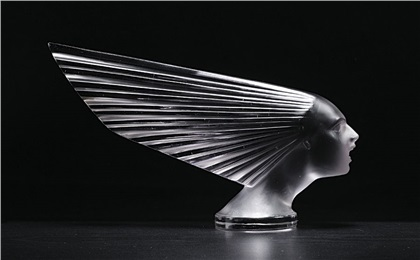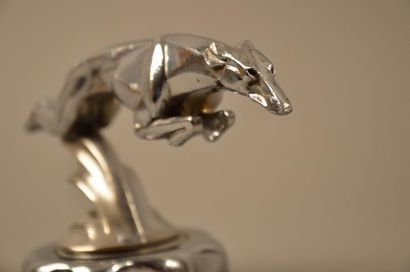The most eccentric radiator cap mascots
- COCKPIT

- May 20
- 6 min read
Since the beginning of its history, the automobile industry has been closely associated with art. Brands have approached their names through emblems and mascots to give prestige and glory to their models. But it was shortly before the First World War that the trend for mascots affixed to radiator caps began to revive, gaining momentum during the 1920s.

- Bentley
THE FLYING B
In addition to creating Bentley's winged B badge, renowned artist F. Gordon Crosby also designed an "Icarus" bonnet mascot. This appeared in some early Bentley catalogues but was never produced, possibly due to copyright infringement.
Instead, Cricklewood-era Bentley owners of the mid-1920s were offered the option of the company's first approved Flying B mascot—an ornate, upright brass "B" with horizontally held wings, also believed to be a Crosby design.

FLYING HIGHER
By the 1930s, the "silent sports cars" built by Bentley in Derby had become lower and more elegant. So, in 1933, artist Charles Sykes, designer of the Rolls-Royce Spirit of Ecstasy, was commissioned to create a new mascot.
Sykes designed a single wing with a forward-leaning "B" in the Art Deco style, with facets that allowed the "B" to be read correctly when viewed from either side. However, the single wing was not popular, so the design was modified to feature a pair of wings.
An alternative, rearward-leaning Flying B was also available for the overdrive MR and MX series Bentleys, to signify their sporting character. Owners had to remember to twist these mascots sideways before opening the hood, otherwise they risked denting the bodywork.
The Return of the Flying B
After the war, a smaller version of the two-winged Flying B mascot appeared on Crewe-built Bentleys until the 1970s, when it was withdrawn due to pedestrian safety legislation that prohibited prominent solid ornamentation.
In 2006, the Flying B made a triumphant return, thanks to a mechanism that made it fully retractable. It was offered on the Azure, Arnage, and Brooklands, and is still available today on the Mulsanne.
Special editions of the Flying B mascot were offered by Bentley's Mulliner division, for limited-edition models, including a dark-tinted version that even included a gold Flying B.
- Bugatti
Rembrandt Bugatti created the "Little Dressed Elephant" in 1904. The original edition was cast in bronze by Adrien-Aurélien Hébrard (1865-1937) and Albino Palazzolo, of which only one example is known to date.
In 1926, the model was modified and transformed into a radiator cap and cast in silver by Claude Valsuani for the Bugatti Royales.
To date, two examples are known. They were sold publicly in 2009 and 2015, both from the Schlumpf family.
Regarding our silver-plated bronze piece, we refer to the work of Greg Morgan. According to him, the Bugatti Owners Club in 1970 commissioned, in agreement with L'Ebé Bugatti, several silver-plated bronze copies of the mascot without the cap.
Subsequently, this sculpture was reproduced in numerous different materials.
Currently, the six radiator caps adorning the Bugatti Royales are multiples.

The success of this mascot was such that it was requested by customers. Marcel Charles Benoist, known as Robert Benoist (1895-1944), aviator during the First World War, racing driver, winner of the 24 Hours of Le Mans in 1937 with Jean-Pierre Wimille (1908-1949) in a Bugatti Type 57G Tank, great resistance fighter during the Second World War, offered exclusively – when he was official agent of Automobiles Bugatti Avenue Montaigne in Paris – a mascot called the elephant egg. Its height is generally 8.5 cm, but some examples are 14 cm high.

- Citroën
Thermometer Cap
In addition to its appearance, this radiator cap provides a water temperature indicator. A common device in the 1920s and 1930s.
2 horsepower for the 2CV, 4 horsepower for the 4CV and 5 horsepower for the 5CV, it's not complicated.
In the 1920s, in addition to the simple thermometer cap, a small flame adorned the hoods of Citroëns. For models with a floating engine, an innovation that eliminated vibrations in the passenger compartment, it was a magnificent swan—a sign that the owner was a man delighted by his automobile.

All the details in our article LIEN 🔗
- De Dion-Bouton
Among the first brands to feature a mascot, here one from 1904.

- Delage
When you own a Delage, it's a shame to settle for a simple thermometer. So, we often chose this "Figure of Speed" by Paul Auscher. But Delage also has surprising and unusual mascots.
- DODGE
An emblem that can lead to controversy.

All the details in our article LIEN 🔗
- FIAT
In 1911, FIAT surprised everyone with its mascot of an Indian riding a snail. It was the Palme d'Or of creativity, but it didn't last long.

- HISPANO SUIZA
The Hispano Suiza stork is a tribute to Captain Guynemer, whose Hispano-powered plane was adorned with a stork.

- Queen Elizabeth II's Mascots
Queen Elizabeth had a special affection for Corgis, so much so that she became the mascot for these cars.

All the details in our article LIEN 🔗
- Packard
Combining aesthetics and utility is what Packard did in the 1930s by incorporating the radio antenna into the pelican-shaped mascot's "feathers." This mascot, nicknamed the "Cormorant," features a highly stylized design to match the family's coat of arms.

All the details in our article LIEN 🔗
- Peugeot
The lion brand has released numerous variations of its lion mascot, however, there is one that should have been avoided.

-Rene Lalique
Between 1925 and 1931, René Jules Lalique (1860-1945), master of Art Deco glass, created around thirty radiator cap models, primarily inspired by nature. He used pressed, molded white glass, with a satin, matte, or glossy finish, set at the base with a notched wheel that screws onto the radiator mounting bracket.

- Rolls-Royce
The most famous mascot of the entire automotive industry, the Spirit of Ecstasy, was imagined and created in 1911 by British sculptor Charles Sykes. This statuette has had many nicknames, first called the Spirit of Speed and then the Flying Lady in the United States. It is also sometimes referred to as Emily or Silver Lady. This statuette has survived through the generations without much change.

It all began with a bronze statue called The Whisperer, commissioned by a certain John Scott Montagu to Charles Sykes. Sykes worked as an illustrator for the magazine The Car Illustrated, of which Lord Montagu of Beaulieu was the editor.
In 1909, Lord Montagu asked Charles Sykes to create a mascot to adorn the front of his Rolls-Royce. The sculptor used Eleanor Valesco Thornton, Lord Montagu's secretary and mistress for 13 years, as the model.

The original statue of The Whisperer differs from the one we know today: there is a finger over the woman's mouth, which gives rise to different interpretations. For some, this evokes the close relationship between Eleanor and Lord Montagu. For others, it is a way of indicating that the engine is silent.
In 1934, Sykes created a kneeling version of his Flying Lady for the Sports Saloon model, which was also seen on the Silver Wraith and Silver Dawn in the 1950s.
Eleanor, for her part, met a tragic end, dying when the ship carrying her to India was torpedoed in 1915.
The statue of The Whisperer is on display, along with many Spirit of Ecstasy models, at the National Motor Museum in Beaulieu, in southern England.

In its modern version, it is made of crystal and illuminated. Unfortunately, it was quickly banned in Europe in 2020. The reason for this strange decision is that the illuminated sculpture does not comply with the new European regulations on light pollution. After disconnecting it, Rolls will reimburse owners for the option price and replace the famous Flying Lady with a silver Spirit of Ecstasy.

Luxury Alliance with Fabergé 100 years after the fall of the Romanov dynasty. Rolls-Royce believes these "exceptionally precious creations are among the most important and coveted objects ever created," adding, "As eggs are synonymous with wealth and attention to detail, Rolls-Royce and Fabergé have partnered to create a new egg for 'a discerning customer'."
Rolls-Royce explained that the egg's design was created by their designers Stefan Monro and Alex Innes. It was then crafted by Fabergé's senior designer, Liisa Tallgren, and brought to life by a team of seven artisans.
According to Rolls-Royce, while Fabergé eggs remain popular, the Spirit of Ecstasy egg is only the "second to be commissioned in the 'Imperial Class' since 1917—a category reserved for Fabergé's most illustrious creations." The egg is truly remarkable, as even its rotating base is crafted from 18-carat white gold, hand-engraved and finished with a purple enamel guilloché pattern.
The egg's shape is created by "rose gold arms" covered with nearly 10 carats of round white diamonds. They finally give way to purple amethysts weighing over 390 carats, specially selected for their "color saturation and quality." These unique elements form a protective cocoon around the Spirit of Ecstasy, created from hand-carved frosted rock crystal.
As the egg is of the Imperial class, it has a "surprise and delight" feature, just like its predecessors. In this case, a lever at the base "opens" the egg and releases the Spirit of Ecstasy from its luxurious prison.
- ROVER
A former British car manufacturer, Rover proudly displays a Viking head on its vehicles, yet this Scandinavian people invaded and carried out numerous raids and pillages in the British Isles. Perhaps this is due to "Stockholm syndrome."

- Packard Adonis
His origins lie in the Greek god Adonis, an eternally youthful god of beauty and desire.




























Comments